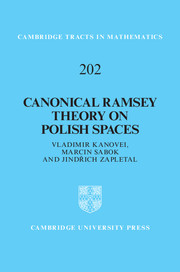Book contents
- Frontmatter
- Contents
- Preface
- 1 Introduction
- 2 Background facts
- 3 Analytic equivalence relations and models of set theory
- 4 Classes of equivalence relations
- 5 Games and the Silver property
- 6 The game ideals
- 7 Benchmark equivalence relations
- 8 Ramsey-type ideals
- 9 Product-type ideals
- 10 The countable support iteration ideals
- References
- Index
3 - Analytic equivalence relations and models of set theory
Published online by Cambridge University Press: 18 December 2013
- Frontmatter
- Contents
- Preface
- 1 Introduction
- 2 Background facts
- 3 Analytic equivalence relations and models of set theory
- 4 Classes of equivalence relations
- 5 Games and the Silver property
- 6 The game ideals
- 7 Benchmark equivalence relations
- 8 Ramsey-type ideals
- 9 Product-type ideals
- 10 The countable support iteration ideals
- References
- Index
Summary
Let I be a σ-ideal on a Polish space X. The key idea underlying much of the current of thought in this book is the correspondence between Borel equivalence relations on X and intermediate forcing extensions of the generic extension given by the quotient poset PI of Borel I-positive sets ordered by inclusion. The correspondence is easiest to illustrate on smooth equivalence relations. If E is a smooth equivalence on X and f: X → 2ω is a Borel function reducing it to the identity, then the model V[f(ẋgen)] depends only on E and not on the choice of the reduction. However, we need to find a sufficiently general definition that covers the nonsmooth case, where most of the interest and difficulty lies.
The main application of the concepts developed in this chapter is the following immediate consequence of the more technical trichotomy theorem (Theorem 3.5):
Theorem 3.1Suppose that I is a σ-ideal on a Polish space X such that the poset PI is proper and the PI-extension is a minimal forcing extension. For every I-positive Borel set B ⊂ X and every analytic equivalence relation E on B, there is an I-positive Borel subset C ⊂ B such that E ↾ C = id or E ↾ C is ergodic.
- Type
- Chapter
- Information
- Canonical Ramsey Theory on Polish Spaces , pp. 45 - 61Publisher: Cambridge University PressPrint publication year: 2013

